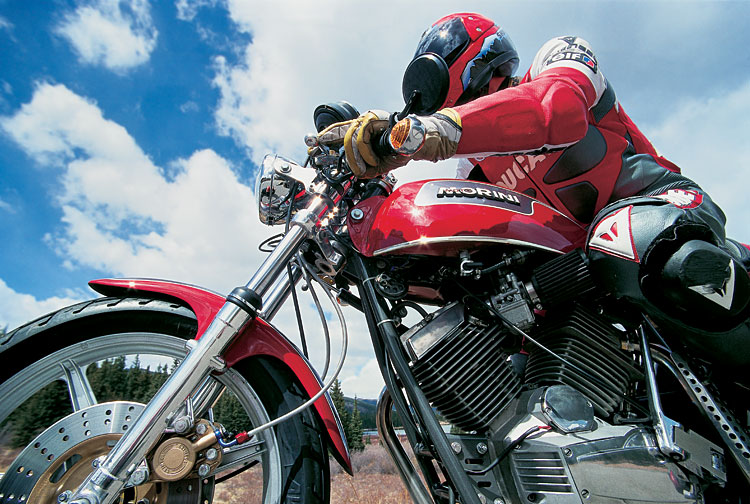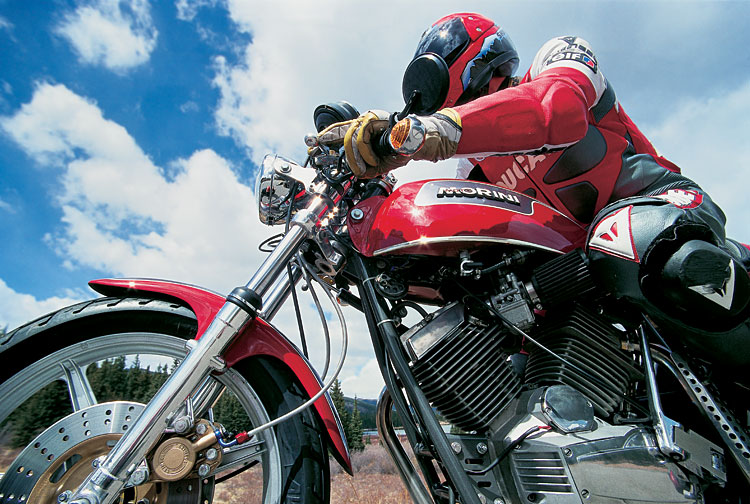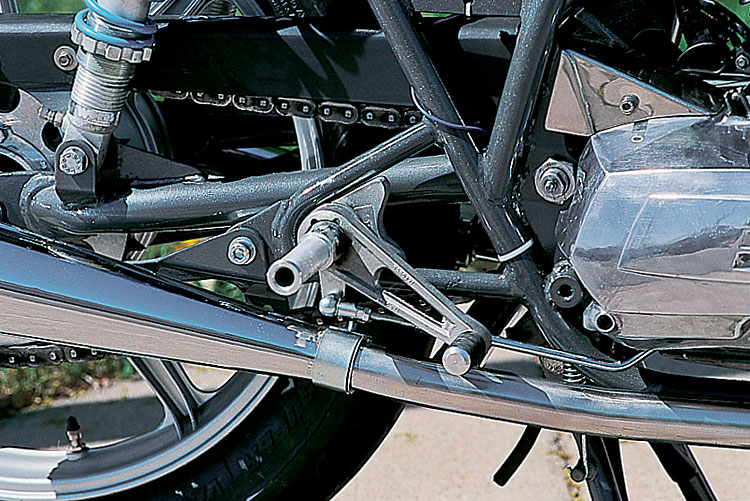The Moto Morini Story

After a long snowy winter and six busy months of restoration it's time to face the truth. Did I do a good job and will the Italian primadonna finally sing?
Alfonso Morini, the owner of the little Italian manufacturer from Bologna, started out in the motorcycle business in 1924. Together with businessmen Massi, Mattei and Mazzetti, he founded the "Fabricca di Motobiciclette Brevetti M.M. di A. Mattei & Co.," M.M. for short. In the beginning they produced 125 and 175cc two strokes, and in 1930 they began to produce four strokes. Alfonso himself won the 125cc class at the GP of Monza in 1927.
In 1937 Signore Morini left the company to start his own enterprise: Moto Morini. At first, he manufactured small three-wheeler trucks and aircraft parts. Later on, in 1946, he started producing motorcycles, mainly two strokes with small capacities. The first model was the Turismo 125. At the end of the forties he built a 125cc four-stroke racebike. The first 175 followed in 1952/1953. It was the precursor of the famous race version, Settebello, which appeared at the end of 1953. This bike won many national races and championships, and one of its riders was Giacomo Agostini.

Even more acclaimed was the 250 GP Bialbero developed by Dante Lambertini. In 1963, Tarquinio Provini almost won the world championship on this bike and placed second behind Honda four-cylinder rider Jim Redman. Even today, the 40-hp Bialbero remains the strongest 250cc four-stroke single ever built. At the end of the season Morini quit GP racing. From 1967 through 1975 the make successfully entered off-road events like the traditional Six Days with their 125/150/175 Regolaritá Casa.
Alfonso Morini died in 1969, leaving the business to his daughter, Gabriella Morini. It was time for a change. At the Milan show in 1973 Morini presented a brand-new 350 with a compact V-twin four-stroke engine, called the 3 ½ Strada. The parallel valves were operated by pushrods and rockers, the ohv-cam was belt driven. The Heron combustion chamber was integrated in the pistons. From this bike other models like a 3 ½ Sport developed that were responsible for the make's success in the seventies. A 500 version (478cc) came in 1978, later on 125 (H) and 250 (T) singles, as well as a 250 V-twin (J). The first enduro model was the 500 Camel in 1981, followed by a 350 Kanguro in 1982, and a bigger 501 Camel (507cc) in 1985. For the U.S., Herman Baver, the proprietor of Herdan Corporation, imported and distributed these bikes from Bologna. He used to travel to Italy twice a year and built a following and good reputation among American Morini enthusiasts. That hasn't changed. He's still in business and can supply a lot of parts (address and phone number in the technical specs box).

Back to the eighties: The Japanese had conquered markets all over the world and the pushrod singles and V-twins couldn't succeed against the modern, less-expensive designs from the Land of the Rising Sun. In 1986, Morini was purchased by the brothers Claudio and Gianfranco Castiglioni. Morini, from then on, belonged to their brand, Cagiva, which also included Ducati and Husqvarna (even MV Agusta but there weren't any bikes produced at that time). Starting in 1989, the enduros were called 350/501 Coguaro. After the cruiser models 350/501 Excalibur and New York, the 350 and 400 Dart were definitely the last Morinis. In 1991, Cagiva quit building Morinis.
But there is hope for a revival. In 1999, the little Italian make, Motori Franco Morini (founded by a cousin of Alfonso) bought the rights to the name Moto Morini and Franco Lambertini, the engineer who developed the 3 ½ engine and its sisters, was hired. Lambertini is also responsible for Franco Morini's new small capacity four-stroke motor, currently used by the German manufacturer Simson in their 125 standard and 125 RS sportbike.

Based on this engine, the custom-builder Roberto Totti of Bologna created a sharp-looking café racer with the swingarm of a Cagiva Mito. For more insights into the possible future of Morini, go to: www.ital-web.de, and look at "umbauten/Robert - Corsaro 2002".
The time has come! The red and silver beauty is standing in the driveway waiting for me. It seems like all her muscles are ready to jump on the road. Six months of hard work involving liters of sweat and bloodied fingers from polishing aluminum and chrome and putting the chassis and engine parts together - the work is done. Now you have to show me you were worth it, Signora!

My cold fingers reach for and pull the tiny choke levers on the Dellorto carbs. Both petcocks in ON-position, two or three kicks on the kickstart lever for getting the oil up to the top of the pushrods and the valve rockers. Then, ignition ON, my foot searches for the top-dead center. Take a deep breath and kick as hard as you can. Bolopp! Nothing. Once again: find TDC, take another breath and kick. Bolopplopplopplopp... It's running! Only those who have done intensive work on a piece of machinery can imagine the pleasure and pride that's felt when it's finally running. Well, let's say idling. We haven't been riding yet.
So, let's go. Let's pull onto the backroads of Colorado! After a few miles I drop the choke levers and let it warm up - 4,000, 5,000 rpm are just the right levels to bring the Morini to the right operating temperature. The town of Morrison isn't busy yet; it's still early on a Sunday morning, and all the tourists will hold off for a couple of hours. Watch out for the cops just outside of town. This ridiculous 25-mph posting is just an excuse to line the community's wallet.

Okay, here are the first turns. Will the combination of 350 chassis and 500 engine prove to be the right choice? It certainly looks fine. Third, fourth gear, and we are alone on the road. Alone with our feelings for each other, alone with our abilities to make it a fun ride. I try to give my best as a rider, try to put as much weight on the front end as I can - actually, I have to because I mounted the clip-ons so low that my friends think I graduated from a yoga class last winter. But I like this riding position. It's exactly what I need. I wanna feel what the front wheel is doing.
The roads are empty. It seems no one else had the idea to get out this early. Here's the canyon. Passing the towns of Idledale and Kittredge, I inhale the fresh air with its bit of moisture from Bear Creek. We arrive in Evergreen; everything on the bike seems to be fine. I stop at the Conoco station and check all the fuel and oil lines. Nothing is leaking: Okay, let's continue. Bergen Park, and a left turn onto Highway 66, locally known as Squaw Pass Road. The engine should be warm by now and I let it rev a little higher - 6,000, 6,500 rpm, that's enough for now. It's getting cooler and my racing leathers seem stiffer. No wonder, we're approaching altitudes of 8,500 feet. The temperature is about 15 degrees lower than at our starting point in Lakewood. What's that? The bike struggles a little bit when I shift into fifth? Carefully, I listen to the engine sounds but all I can hear is the running noise of the small belt drive for the cam and the ticking of the valves that signals they have enough clearance. I may have to go to the doctor to get my hearing checked. It's annoying when you think you hear something that isn't there.

At this altitude the aspens on the side of the road haven't unfurled their bright green leaves yet. But you can smell it in the air; spring is coming back and with it our passion for riding. The shifting system is well adjusted but again I feel this struggling when I shift to a higher gear. Fifth is the worst. It might be the jetting, which makes it even worse at higher altitudes. We're almost at Echo Lake. Then, suddenly, gravel and sand in my riding line. I try to pull the bike a little bit to the outer side but in the same moment we come close to the banking. Actually, there is no banking, just an edge, and ... more sand. We make it, perhaps because of the steering damper that usually belongs on a CBR600F3.
Now I'm awake. Well, buddy, that can happen when you ride on a mountain road that doesn't offer the cleanest pavement. You can run into gravel almost everywhere. Ice and snow wouldn't surprise me. Also, you can feel lots of bumps, even with the expensive custom-made Works Performance shocks. But it seems like the Morini and I are warmed up now and getting along pretty well. There's the lake, time for another machinery check. While the bike is still running I go over all the connections and most importantly, the fasteners. Looks okay to me. But what's that? The small labyrinth I installed in the breather tube is jumping up and down with the beat of the V-Twin. Well, not to worry, it can't go anywhere!

Then back on the road enjoying the wide and tight turns down to Idaho Springs. Passing the first neighborhoods and the little lake popular with wild-trout fishermen, I get into town. At the gas station on the other side of I-70 we fill up. Right next to our pump is a Harley rider fiddling with his gear bag on the front of the forks. He comes over to chat. "What the heck is that? I didn't even know that they made such small displacements in their Vees."
Sorry, the poor fellow thinks it's another bike from Milwaukee. It's not. It's fine workmanship from Italian pizza bakers. Great arrangement, no part too much. All the ingredients on a thin crust. Even the little power output could probably kick your iron-horse butt on a curvy road because of the hp-to-weight ratio. But I'll keep my mouth shut, I'm thinking. I want to enjoy the morning; and honestly, I still have to pay so much attention to my hardware that I cannot lose control of myself.

Unfortunately, it takes about ten to eleven kicks to get my lovely girl started. And of course, the Harley-guy is still around and casually pushes the button for the starter motor to get his bike running. This is one of those moments in the life of a mechanic when he wants to dig a very deep hole. But then, finally, the Morini runs again. Let's take I-70 and get some miles under the belt.
Five minutes later we pull off the Interstate to get on 6th Avenue, heading towards Golden, another gorgeous canyon road. Traffic has picked up and I have to pass more often. The little V-Twin under me roars a chromatic aria from its megaphones. No doubt about it, I made the right choice to get back on the Morini track. Arriving in Golden, the bike runs much better, owing to the change in elevation. It's also getting warmer and my leathers feel like a sponge of hot water.
We pull onto 19th and turn off on Colfax heading east. Susie's Bart Grill, the biker stop, is already packed with crowds of bikers and bikes, most of them Harleys. For a moment I think about stopping. But, then again, I remember my embarrassment in Idaho Springs. Maybe, she won't start again afterwards. Let's go home. My wife and my little boy should be awake by now, and sharing a nice breakfast with them sounds better...
- 350 frame/500 engine
- individual K & N air filters
- British megaphones
- chromed clip-ons, low
- small headlight
- small tail light
- two manual petcocks instead of electrical/manual setup
- Ducati 900 SS (bevel drive) seat panel
- cut Motocross rear fender
- 1.3 Ah battery
- new panel for electric system underneath the seat
- high-power output regulator (Bike Affairs Bredenbek, Germany)
- Works Performance rear shocks
- paint job (red/silver)
Technical Specs
Model Year 1981/1978
Retail Price $ 2,795 (model 500 Sport, 1979)
Warranty 6 months or 6,000 miles (1979)
Maintenance Schedule 300/1,200, every 1,200 miles (500/2,000/every 2,000 km)
Former Importer/Distributor Herdan Corporation
Route 61, Port Clinton, PA 19549,
phone (610) 562-3155,
fax (610) 562-0062,
e-mail: hwbaver@hermys.com
Engine
Type 2-cylinder, V, 4-stroke
Cooling air-cooled
Valve Arrangement 2 valves per cyl., ohv, cam belt driven, pushrods and rockers
Bore & Stroke 69 x 64 mm
Displacement 479 cc
Compression Ratio 11.2:1
Carburetion two 26 mm carburetors
Exhaust Emission Control no
Transmission
Gearbox 5-speed (1978)
Clutch multi-plate dry clutch
Final Drive chain drive
Chassis
Frame steel tubular frame, double cradle
Wheelbase 1,385 mm (350 Strada; 54.5 in.)
Rake 61 degree
Trail 101 mm (3.9in.)
Front Suspension inverted cartridge fork
Stanchion Diameter 35 mm (1.38 in.)
Adjustments no
Travel 120 mm (4.75 in.)
Rear Suspension steel swingarm w/two shocks
Adjustments spring preload
Travel 70 mm (2.75 in.)
Wheels & tires
Type cast alloy wheels
Front 1.85 x 18
Rear 2.15 x 18
Front Tire 100/90-18
Rear Tire 110/90-18
Brakes
Front Brake 2 discs, 2-piston calipers
Diameter 260 mm (10.2 in.)
Rear Brake drum brake, single leading shoe
Diameter 180 mm (7.1 in.)
Combining no
Weight & Fuel Capacity
Wet-Weight 167 kg (371 lb.)
Fuel Capacity 13 l (3.4 gal.)
Performance
Claimed Horsepower (crank)43 hp at 7,500 rpm
Torque 4.43 mkp (32.8 ft.-lbs.) at 5,100 rpm
Top Speed (Claimed)175 km/h (109 mph)
Acceleration 0-100 km/h (0-62.5 mph): na
Fuel Consumption 4.9 l/100 km (48.5 mpg)
Fuel Range 265 km (166 miles)
Equipment
Dashboard w/speedometer, odometer, tachometer, key switch on the left side below tank, side and center stand.
RoadRUNNER Test Diagram
Engine 3/5
Chassis 4/5
Brakes 4/5
Comfort 2/5
Luggage w/accessories 1/5
Equipment 3/5
Design 5/5
Bike for the buck 3/5











